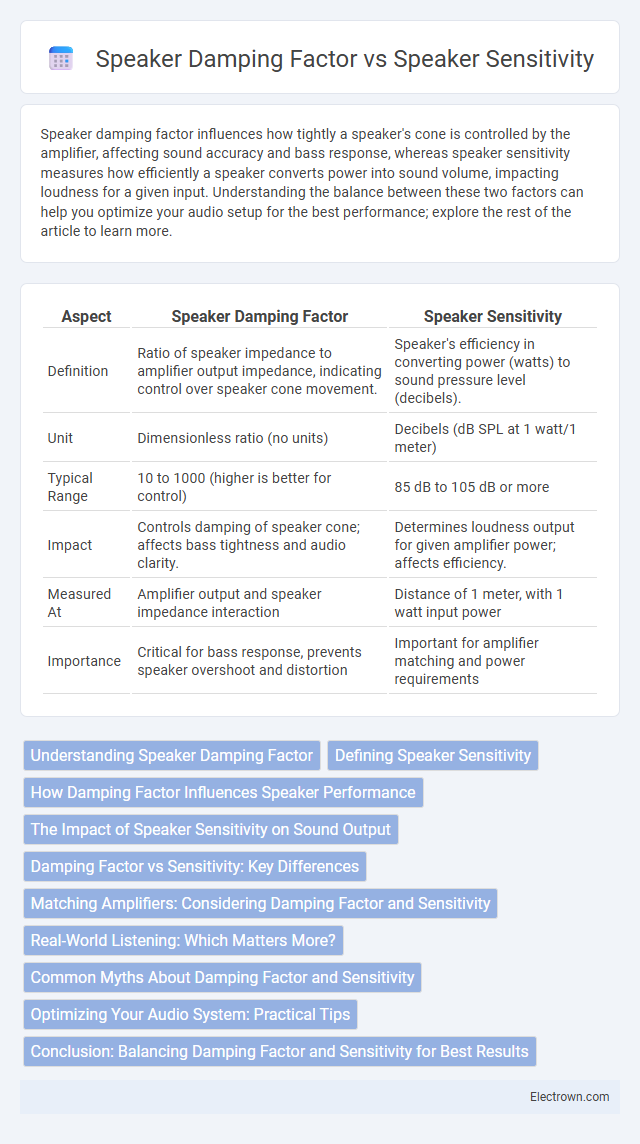Speaker damping factor influences how tightly a speaker's cone is controlled by the amplifier, affecting sound accuracy and bass response, whereas speaker sensitivity measures how efficiently a speaker converts power into sound volume, impacting loudness for a given input. Understanding the balance between these two factors can help you optimize your audio setup for the best performance; explore the rest of the article to learn more.
Table of Comparison
| Aspect | Speaker Damping Factor | Speaker Sensitivity |
|---|---|---|
| Definition | Ratio of speaker impedance to amplifier output impedance, indicating control over speaker cone movement. | Speaker's efficiency in converting power (watts) to sound pressure level (decibels). |
| Unit | Dimensionless ratio (no units) | Decibels (dB SPL at 1 watt/1 meter) |
| Typical Range | 10 to 1000 (higher is better for control) | 85 dB to 105 dB or more |
| Impact | Controls damping of speaker cone; affects bass tightness and audio clarity. | Determines loudness output for given amplifier power; affects efficiency. |
| Measured At | Amplifier output and speaker impedance interaction | Distance of 1 meter, with 1 watt input power |
| Importance | Critical for bass response, prevents speaker overshoot and distortion | Important for amplifier matching and power requirements |
Understanding Speaker Damping Factor
Speaker damping factor measures an amplifier's ability to control the movement of a speaker's cone, directly impacting sound clarity and bass precision. Higher damping factors lead to tighter, more accurate audio reproduction by reducing unwanted cone vibrations. Your speaker sensitivity determines how efficiently a speaker converts power into sound, but optimal damping factor ensures better control and improved overall audio performance.
Defining Speaker Sensitivity
Speaker sensitivity measures how effectively a speaker converts amplifier power into sound, typically expressed in decibels (dB) per watt at one meter distance. A higher sensitivity means your speaker produces louder sound with less power, crucial for efficient audio playback. Understanding sensitivity helps optimize your audio setup alongside damping factor, which impacts speaker control and sound quality.
How Damping Factor Influences Speaker Performance
Damping factor significantly influences speaker performance by controlling the amplifier's ability to regulate speaker cone movement, reducing distortion and improving sound clarity. A higher damping factor means tighter control over the speaker, resulting in more precise bass response and less unwanted resonance. Your audio system benefits from improved transient response and cleaner sound reproduction when the amplifier's damping factor effectively matches the speaker's impedance and sensitivity.
The Impact of Speaker Sensitivity on Sound Output
Speaker sensitivity directly influences the sound output by determining how efficiently a speaker converts power into volume, measured in decibels (dB) per watt at one meter. A higher sensitivity rating means your speaker can produce louder sound with less amplifier power, enhancing overall audio performance in various listening environments. While the damping factor affects control over speaker movement, sensitivity primarily impacts the perceived loudness and clarity of the sound you experience.
Damping Factor vs Sensitivity: Key Differences
Damping factor refers to an amplifier's ability to control a speaker's movement, impacting sound tightness and bass precision, while speaker sensitivity measures how efficiently a speaker converts power into volume, expressed in decibels (dB). Higher damping factor values improve control over the speaker cone, reducing distortion at low frequencies, whereas greater sensitivity results in louder output at a given power level. Understanding the distinction is crucial for matching amplifiers and speakers to achieve optimal audio performance with both power efficiency and sound accuracy.
Matching Amplifiers: Considering Damping Factor and Sensitivity
Matching amplifiers with speakers requires careful consideration of both damping factor and speaker sensitivity to achieve optimal audio performance. The damping factor, related to amplifier output impedance and speaker impedance, influences control over speaker cone movements and reduces distortion, while sensitivity determines how efficiently a speaker converts power into sound, affecting volume levels for a given amplifier power. Ensuring your amplifier's damping factor complements your speaker's sensitivity helps deliver clear, dynamic sound with precise control and minimal distortion.
Real-World Listening: Which Matters More?
Speaker damping factor primarily influences the control and precision of a speaker's driver movement, affecting bass clarity and reducing distortion, while speaker sensitivity measures how efficiently a speaker converts power into sound, impacting overall loudness. In real-world listening environments, sensitivity often matters more for achieving adequate volume levels without requiring excessively powerful amplifiers. However, for audiophiles prioritizing sound accuracy and tight bass response, a high damping factor can significantly enhance listening quality.
Common Myths About Damping Factor and Sensitivity
Common myths suggest that a higher damping factor always guarantees better speaker control, but in reality, speaker sensitivity often has a more noticeable impact on loudness and overall performance. Damping factor, which measures an amplifier's ability to control speaker movement, rarely affects typical home audio setups as much as sensitivity, expressed in decibels (dB), which directly influences how efficiently a speaker converts power into sound. Your focus should be on speaker sensitivity to achieve desired volume levels with less amplifier power, while damping factor considerations matter primarily in specialized or professional audio environments.
Optimizing Your Audio System: Practical Tips
Optimizing your audio system involves understanding the impact of speaker damping factor and speaker sensitivity on sound quality. A high damping factor improves control over the speaker's movement, reducing distortion and enhancing clarity, while high speaker sensitivity requires less amplifier power to reach desired volume levels. Balancing these factors ensures efficient amplifier-speaker pairing for optimal audio performance and minimal energy loss.
Conclusion: Balancing Damping Factor and Sensitivity for Best Results
Achieving optimal audio performance requires balancing speaker damping factor and sensitivity, as a high damping factor improves control over speaker cone movement, reducing distortion, while high sensitivity ensures louder output with less amplifier power. Excessively high damping factors may offer diminishing returns, especially with sensitive speakers that already produce clear sound at lower power. Prioritizing an appropriate combination tailored to the specific speaker design and amplifier capabilities delivers the best sound clarity and efficiency.
speaker damping factor vs speaker sensitivity Infographic

 electrown.com
electrown.com